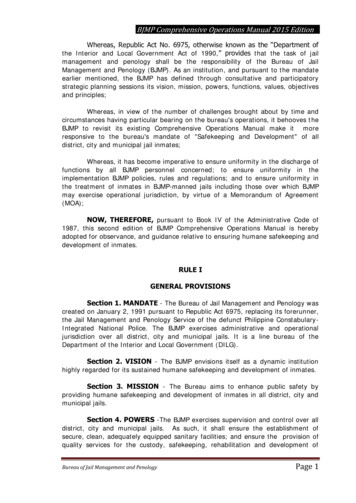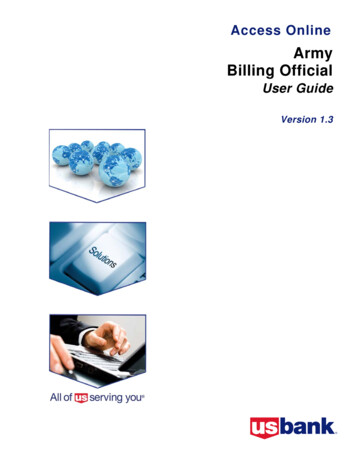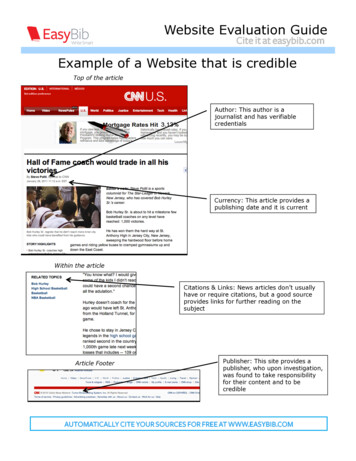
Transcription
BJMP Comprehensive Operations Manual 2015 EditionWhereas, Republic Act No. 6975, otherwise known as the “Department ofthe Interior and Local Government Act of 1990,” provides that the task of jailmanagement and penology shall be the responsibility of the Bureau of JailManagement and Penology (BJMP). As an institution, and pursuant to the mandateearlier mentioned, the BJMP has defined through consultative and participatorystrategic planning sessions its vision, mission, powers, functions, values, objectivesand principles;Whereas, in view of the number of challenges brought about by time andcircumstances having particular bearing on the bureau's operations, it behooves theBJMP to revisit its existing Comprehensive Operations Manual make it moreresponsive to the bureau's mandate of "Safekeeping and Development" of alldistrict, city and municipal jail inmates;Whereas, it has become imperative to ensure uniformity in the discharge offunctions by all BJMP personnel concerned; to ensure uniformity in theimplementation BJMP policies, rules and regulations; and to ensure uniformity inthe treatment of inmates in BJMP-manned jails including those over which BJMPmay exercise operational jurisdiction, by virtue of a Memorandum of Agreement(MOA);NOW, THEREFORE, pursuant to Book IV of the Administrative Code of1987, this second edition of BJMP Comprehensive Operations Manual is herebyadopted for observance, and guidance relative to ensuring humane safekeeping anddevelopment of inmates.RULE IGENERAL PROVISIONSSection 1. MANDATE - The Bureau of Jail Management and Penology wascreated on January 2, 1991 pursuant to Republic Act 6975, replacing its forerunner,the Jail Management and Penology Service of the defunct Philippine ConstabularyIntegrated National Police. The BJMP exercises administrative and operationaljurisdiction over all district, city and municipal jails. It is a line bureau of theDepartment of the Interior and Local Government (DILG).Section 2. VISION - The BJMP envisions itself as a dynamic institutionhighly regarded for its sustained humane safekeeping and development of inmates.Section 3. MISSION - The Bureau aims to enhance public safety byproviding humane safekeeping and development of inmates in all district, city andmunicipal jails.Section 4. POWERS -The BJMP exercises supervision and control over alldistrict, city and municipal jails. As such, it shall ensure the establishment ofsecure, clean, adequately equipped sanitary facilities; and ensure the provision ofquality services for the custody, safekeeping, rehabilitation and development ofBureau of Jail Management and PenologyPage 1
BJMP Comprehensive Operations Manual Revised 2015district, city and municipal inmates, any fugitive from justice, or person detainedawaiting or undergoing investigation or trial and/or transfer to the NationalPenitentiary, and/or violent mentally ill person who endangers him/herself or thesafety of others as certified by the proper medical or health officer, pendingtransfer to a mental institution.Section 5. FUNCTIONS -In line with its mission, the Bureau endeavors toperform the following functions:a. to enhance and upgrade organizational capability on a regular basis;thus, making all BJMP personnel updated on all advancements in lawenforcement eventually resulting in greater crime solution efficiencyand decreased inmate population;b. to implement strong security measures for the control of inmates;c.to provide for the basic needs of inmates;d. to conduct activities for the rehabilitation and development of inmates;ande. to improve jail facilities and conditions.Section 6. Vision, Mission, Objectives and Functions of Directoratefor Operationsa. Vision – A Directorate that will be instrumental in the humanesafekeeping of inmates.b. Mission – To enhance jail management by formulating policies andguidelines on humane safekeeping of inmates and ensure theircompliance in all district, city and municipal jails.c.Objectives-Page 2To monitor the compliance by wardens with the differentoperational policies and regulations set forth by the bureau;To help enhance the security and safety of the inmates as well asthe jail facilities;To equip the personnel with the necessary skills in the effectivemanagement of jail security and safekeeping of inmates.To ensure that the bureau complies with its directives pertaining tojail operations; andTo ensure that the bureau complies with the principles relative touse of different international instruments in the humane treatmentof inmates.Bureau of Jail Management and Penology
BJMP Comprehensive Operations Manual 2015 Editiond. Functions--Advises and assists the BJMP chief on matters relating to theformulation and execution of correctional programs, particularly asregard organization, training, operation and planning;Formulates and implements policies, guidelines, and programsrelating to security, custody, discipline and control of offenders;Conducts periodic inspection of jail facilities and supervision overjail facility personnel; reviews matters concerning penology such ascustody, security, discipline and control of offenders; and ensuresthat the same are properly and religiously implemented;Formulates plans, programs, policies and guidelines for theeffective nationwide implementation of rehabilitation programs andservices for all inmates;Coordinates with private and government agencies and solicits theirassistance and support for rehabilitation programs in jailsnationwide; andPerforms such other functions as the BJMP chief may direct.Section 7. DISTRICT JAIL - In large cities or a group of clusteredmunicipalities, a district jail headed by a district warden may be established.Section 8. CITY AND MUNICIPAL JAILS - The BJMP operates andmaintains city and municipal jails, each headed by a city or municipal warden, asthe case may be.Section 9. CORE VALUES -The BJMP’s officers and staff are guided bythe following core values:a. Commitment - strong sense of dedication to the ideals of theorganization and to the public that it serves;b. Respect for Human Rights - to promote and protect the rights ofour fellow human beings;c.Efficiency/Competence - mastery of important skills for delivery ofquality services;d. Cooperation - willingness to share efforts in implementing plans andachieving goals; ande. Teamwork - the combined effective action of all personnel.Section 10. OBJECTIVES -The broad objectives of the Bureau are thefollowing:a. To improve the living conditions of offenders in accordance with theaccepted standards set by the United Nations;Bureau of Jail Management and PenologyPage 3
BJMP Comprehensive Operations Manual Revised 2015b. To enhance the safekeeping, rehabilitation and development ofoffenders in preparation for their eventual reintegration into themainstream of society upon their release; andc.To professionalize jail services.Section 11. PRINCIPLES - The following principles shall be observed inthe implementation of the preceding sections:a. Humane treatment of inmates;b. Observance of professionalism in the performance of duties; andc.Multi-sectoral approach in the safekeeping and development of inmatescan be strengthened through active partnership with other members ofthe criminal justice system and global advocates of corrections.Section 12. DEFINITION OF TERMS - As used in this Manual, thefollowing terms are defined:Alcoholics - those inmates who suffer from alcoholism or those engagedin the improper compulsive intake of alcohol which may result in physical,social and behavioral problems.Bisexual - are those inmates who have a sexual attraction or sexualbehavior toward both males and females, and may also encompass sexualattraction to people of any gender identity or to a person irrespective ofthat person’s biological sex or gender.Carpeta - otherwise known as “inmate record or jacket”, contains thepersonal and criminal records of inmates, documents related to his/herincarceration such as but not limited to: commitment order, subpoenas,personal identification, orders from the court, and all other papersnecessarily connected with the detention of an inmate.Child or Children in Conflict with the Law (CICL), also known as“Youth Offender” - a person under eighteen (18) years old who is allegedas, accused of or adjudged as having committed an offense under thePhilippine laws.Chief Custodial Officer - is the personnel in-charge in the overallsupervision of all custodial functions.City Jail - is a facility or a place of confinement for those inmates who aresentenced with a penalty from (1) one day to three (3) year imprisonment.Clustering of Jails - the designation of a municipal or city Jail as a facilityfor one or more adjacent municipalities in order to maximize the utilizationPage 4Bureau of Jail Management and Penology
BJMP Comprehensive Operations Manual 2015 Editionof personnel and other resources. The “host” city or municipality is namedas a district to accommodate inmates from the municipalities clustered to it.Commitment Order - a written order of the court, or any other agencyauthorized by law to issue, entrusting an inmate to a jail for the purpose ofsafekeeping during the pendency of his/her case.Contraband - any article, item, or thing prohibited by law and/orforbidden by jail rules that would pose as security hazards or endanger thelives of inmates.Conjugal Visitation – refers to the visit by the wife for a short period,usually an hour, more or less, to her incarcerated husband during whichthey are allowed privacy and are generally understood to have sexualcontact.Detainee - a person who is accused before a court or competent authorityand is temporarily confined in jail while undergoing or awaitinginvestigation, trial, or final judgment.District Jail - is a facility or a place of confinement for inmates comingfrom a city or clustered municipalities who are waiting or undergoing trialor serving sentence of one (1) day to three (3) years.Drug Dependents - are those inmates who have a psychological cravingfor habituation to and abuse of or physiologic reliance on a chemical/drugsubstance.Drug Users - are those inmates who take substances/drugs that can altertheir body and mind works.Escape-Prone Inmates - are inmates who are likely and have thetendency to escape from the jail facility.Gay - is a male homosexual inmate, who experiences romantic love orsexual attraction to fellow male inmates.High Risk Inmates in BJMP Jails - are those considered as highlydangerous or with high probability of escaping or being rescued because ofthe gravity of the crimes they are accused of or have a propensity for beingtroublemakers or initiators of jail riots and disturbance and who require ahigh degree of control and supervision. Particularly included herein arethose charged with heinous crimes, such as murder, terrorism, kidnap forransom, violation of R.A. No. 9165, the imposable penalty for which is fromlife imprisonment to death, etc. These also include those who have a recordof escaping from jails, recidivists, habitual delinquents, and those withsevere personality or emotional disorders that make them dangerous totheir fellow inmates or the jail personnel.Bureau of Jail Management and PenologyPage 5
BJMP Comprehensive Operations Manual Revised 2015High Profile Inmates in BJMP Jails - are those who are not necessarilycharged with heinous crimes but are prominent figures in society or publicfigures whose cases have drawn public interest.Infirmed Inmates - are those inmates who are physically or mentallyweak for a prolonged period of time specifically caused by age or illness.Inmate - is the generic term used to refer to a detainee or prisoner.Inmates with Disability - are those inmates who have an impairmentthat may be physical, cognitive, mental, sensory, emotional, developmental,or some combination of these.Inmates with Other Nationalities - are those inmates who are foreignnationals.Instrument of Restraint - a device, contrivance, tool or instrument usedto hold back, keep in, check or control inmates; e.g., handcuffs.Jail - is a place of confinement for city and municipal detainees/prisoners,any fugitive from justice, or person detained awaiting or undergoinginvestigation or trial and/or pending transfer to the National Penitentiary,and/or violent, mentally ill person who endangers him/herself or the safetyof others, duly certified as such by the proper medical or health officer,pending transfer to a mental institution.Jail Aide – is an inmate who requires less supervision than other inmates.Although he/she may be assigned special tasks, he/she has no specialprivileges, and is not allowed to work alone nor exercise any authority overother inmates.Jail Incident -any untoward or uncommon actions, events, or conditionssuch as jail break, riot, noise barrage, stabbing or assault upon personnelthat occurs in jail and perpetrated by any person, which may or may nothave followed or depended upon another action of grave or seriousconsequences such as escape, injury, death, fire, flood, earthquake, orother calamity which affects the jail.Jailbreak - the escape from jail by more than two (2) inmates by the useof force, threat, violence or deceit or by breaching security barriers such asby scaling the perimeter fence, by tunneling and/or by other similar meansor by burning or destructing of the facility or a portion of the facility with orwithout the aid of jail officer or any other person.Jail escape - it is an act of leaving from jail of an inmate through unofficialand illegal ways or without any legal order from the authorities.Jail Warden - person charged with the overall operational andadministrative control of jail.Page 6Bureau of Jail Management and Penology
BJMP Comprehensive Operations Manual 2015 EditionIllegal Contraband- are those that are unlawful in themselves and notbecause of some extraneous circumstances (i.e. dangerous drugs,weapons, potential weapons, explosives).Lesbian - is a female homosexual inmate, who experiences romantic loveor sexual attraction to fellow female inmates.Mentally ill - are those inmates who suffer from mental illness andafflicted with or exhibiting irrationality and mental unsoundness.Mittimus Order - a warrant issued by a court bearing its seal and thesignature of the judge, directing the jail or prison authorities to receiveinmates for the service of sentence.Municipal Jail - is a facility or a place of confinement for those who aresentenced with a penalty for a term not exceeding six (6) monthimprisonment.Nuisance Contraband - are those that may not be classified as illegalunder the Philippine laws but are forbidden by jail rules i.e. cellphone,money or other commodities of exchange such as jewelry, appliances andgadgets, excessive wearing apparels and sleeping paraphernalia,intoxicating liquors, cigarettes, pornographic materials, gamblingparaphernalia and other products that are considered as instruments forvices since they threaten the security, fire safety, sanitation of the facility,and the orderly activities of the jail.Offender - refers to a person who is accused of violating or transgressinglaws and ordinances passed by competent authorities in the Philippines.Officer - in general, the term officer shall refer to all uniformed personnelof the BJMP; when referring to rank, however, the term officer shall refer tothose holding the rank of jail inspector and above.Penology - a branch of criminology dealing with jail management andadministration of inmates.Pregnant Inmates - a female inmate bearing a developing embryo, fetus,or unborn offspring within her body.Prisoner - an inmate who is convicted by final judgment.Provincial Jail – is a facility or a place of confinement for inmates who aresentenced with imprisonment from six (6) months and (1) one to three (3)year imprisonment.Provincial Jail Administrator - refers to the official duly designated tohead the BJMP Provincial Jail Administrator’s Office and to oversee theBureau of Jail Management and PenologyPage 7
BJMP Comprehensive Operations Manual Revised 2015implementation of jail services of all district, city and municipal jails withinits territorial jurisdiction.Reformation - means amending or improving by changing inmate'sbehavior or removing his or her faults or abuse and removing or correctingan abuse a wrong or error.Regional Director - refers to the official duly designated to head theBJMP Regional Office, to oversee the implementation of jail services withinhis/her jurisdiction covering provincial jail administrator’s offices, district,city and municipal jails, and to ensure the enforcement of laws andregulations related to the functions his or her office as mandated of him orher.Regional Office- means an office, which has administrative andoperational control over its provincial jail administrator’s offices, district, cityand municipal jails.Rehabilitation - a program of activity directed to restore an inmate’s selfrespect and sense of responsibility to the community, thereby makinghim/her a law-abiding citizen after serving his/her sentence.Safekeeping - refers to the temporary custody of a person for his/her ownprotection from the community he or she comes from, and for thecommunity he or she comes from.Senior Citizens Inmates - are those inmates who have reached sixtyyears old, or those who have retired from work, and those who generallybelong to the "old age" bracket.Sex Offenders - are those inmates who committed crimes involving sex,including rape, molestation, pedophilia, sexual harassment andpornography production or distributions.Sexual Deviates - inmates who have a type of mental disordercharacterized by a preference for or obsession with unusual sexualpractices, as pedophilia, sadomasochism, or exhibitionism or inmates whosesexual practices are socially prohibited.Suicidal Inmates - are those inmates who have a tendency to commitsuicide or to harm themselves.Transgender - are those inmates whose gender identity or genderexpression does not match with their innate sexual identity.Transfer -the delivery, notwithstanding his/her or their appeal, of aninmate or inmates sentenced to more than three (3) year imprisonment,from any BJMP manned jail to any of the Bureau of Corrections (BuCor)Page 8Bureau of Jail Management and Penology
BJMP Comprehensive Operations Manual 2015 Editionprisons or penal farms or the delivery of an inmate/s from BJMP-mannedjail to another jail facility.RULE IICOMMITMENT AND CLASSIFICATION OF PRISONERS AND DETAINEESA person can be committed to jail only upon the issuance of an appropriateorder by a competent court or authority so mandated under Philippine laws. ThisRule enumerates courts and authorities, and classifies inmates according to theconditions for their commitment.Section 13. COMMITMENT - means entrusting for the confinement of aninmate to a jail by a competent court or authority, for the purposes of safekeepingduring the pendency of his/her case.Section 14.COURTS AND OTHER ENTITIES AUTHORIZED TOCOMMIT A PERSON TO JAIL- The following (courts and entities) are authorizedto commit a person to jail:a.b.c.d.e.f.g.h.Supreme Court;Court of Appeals;Sandiganbayan;Regional Trial Court;Metropolitan/Municipal Trial Court;Municipal Circuit Trial Court;Congress of the Philippines; andAll other administrative bodies or persons authorized by law to arrestand commit a person to jail.Section 15.CLASSIFICATION - refers to assigning or to grouping ofinmates according to their respective penalty, gender, age, nationality, health,criminal records, etc.Section 16.CATEGORIES OF INMATES -The two (2) general categoriesof inmates are:a. Prisoner - inmate who is convicted by final judgment; andb. Detainee - inmate who is undergoing investigation/trial or awaitingfinal judgment.Section 17.CLASSIFICATION OF PRISONERS - The four (4) mainclasses of prisoners are:a. Insular Prisoner - one who is sentenced to a prison term of three (3)years and one (1) day to reclusion perpetua or life imprisonment;Bureau of Jail Management and PenologyPage 9
BJMP Comprehensive Operations Manual Revised 2015b. Provincial Prisoner - one who is sentenced to a prison term of six (6)months and one (1) day to three (3) years;c.City Prisoner - one who is sentenced to a prison term of one (1) dayto three (3) years; andd. Municipal Prisoner - one who is sentenced to a prison term of one(1) day to six (6) months.Section 18.CLASSIFICATION OF DETAINEES - The three (3) classes ofdetainees are those:a. Undergoing investigation;b. Awaiting or undergoing trial; andc. Awaiting final judgment.Section 19. INMATES SECURITY CLASSIFICATION -The following arethe classifications of inmates according to security risk each may pose:a. High Profile Inmate - those who require increased security based onintense media coverage or public concern as a result of their offensesuch as but not limited to those who have been involved in a highlycontroversial or sensationalized crime or those who became prominentfor being a politician, government official, multi-million entrepreneur,religious or cause-oriented group leader and movie or televisionpersonality.b. High Risk Inmate - those who are considered highly dangerous andwho require a greater degree of security, control and supervisionbecause of their deemed capability of escape, of being rescued, andtheir ability to launch or spearhead acts of violence inside the jail. Thisincludes those charged with heinous crimes such as murder, kidnappingfor ransom, economic sabotage, syndicated or organized crimes, etc.Also included are inmates with military or police trainings or thosewhose life is in danger or under imminent threat.c.High Value Target (HVT) - a target, either a resource or a person,who may either be an enemy combatant, high ranking official or acivilian in danger of capture or death, typically in possession of criticalintelligence, data, or authority marked as an objective for a mission andwhich a commander requires for the successful completion of the same.d. Security Threat Group - any formal or informal ongoing inmates’group, gang, organization or association consisting of three or moremembers falling into one of the following basic categories: streetgangs, prison gangs, outlaw gangs, traditional organized crime,aboriginal gangs, subversive groups and terrorist organizations.Page 10Bureau of Jail Management and Penology
BJMP Comprehensive Operations Manual 2015 Editione. Subversive Group - a group of persons that adopts or advocatessubversive principles or policies tending to overthrow or undermine anestablished government.f.Terrorist Group - a group of persons that commits any of thefollowing: piracy and mutiny in the high seas or in the Philippinewaters, rebellion or insurrection, coup d’état, murder, kidnapping andserious illegal detention, crimes involving destruction, arson, hijacking,violation of laws on toxic substances and hazardous and nuclear wastecontrol, violations of atomic energy regulations, anti-piracy and antihighway robbery, illegal and unlawful possession, manufacture, dealingin, acquisition or disposition of firearms, ammunitions or explosives.g. Violent Extremist Offender (VEO) - a person whose political orreligious ideologies are considered far outside the mainstream attitudesof the society or who violates common moral standards and who hasadopted an increasingly extreme ideals and aspirations resorting to theemployment of violence in the furtherance of his/her beliefs.h. Medium Risk Inmates -those who represent a moderate risk to thepublic and staff. These inmates still require greater security, controland supervision as they might escape from and might commit violenceinside the jail.i.Minimum Risk Inmates (Ordinary Inmates) - those inmates whohave lesser tendencies to commit offenses and generally pose the leastrisk to public safety. In most cases, they may be first time offendersand are charged with light offenses.Section 20. REQUIREMENTS FOR COMMITMENT - No person shall becommitted to any jail facility without the following required documents:a. Commitment Order;b. Medical Certificate - recent medical certificate taken within 24 hoursprior to admission;c. Complaint/Information;d. Police Booking Sheet; ande. Certificate of Detention from PNP and/or NBI.RULE IIIRECEPTION AND RELEASING PROCEDURES, CLASSIFICATION BOARD,DISCIPLINARY BOARD AND PUNISHABLE ACTS OF INMATESOne of the Guiding Principles of the United Nations Standard MinimumRules for the Treatment of Prisoners states that “Imprisonment and other measureswhich result in cutting off an offender from the outside world are afflictive by thevery fact of taking from a person the right of self-determination by deprivingBureau of Jail Management and PenologyPage 11
BJMP Comprehensive Operations Manual Revised 2015him/her of his/her liberty. Therefore, the prison system shall not, except asincidental to justifiable segregation or the maintenance of discipline, aggravate thesuffering inherent in such a situation”. Hence, a well-planned and organizedreception of detainees is critical to achieving this. The inmate’s first impression ofthe correctional process greatly influences his/her attitude and behavior toward thecustodial and rehabilitative regimens he/she must undergo during confinement andperhaps, to some extent, affect his/her outlook and adjustment after his/herrelease. This Rule provides guidance on the reception and disciplinary aspects ofjail management.Section 21. RECEPTION PROCEDURES - A decent and humaneprogram of confinement starts with a systematic reception of inmates forcommitment to the BJMP’s jail facilities. The following procedures should thereforebe observed:A. Gater - He or she checks the credentials of the person bringing theinmate/the committing officer to determine his/her identity andauthority. Also, he or she reviews the completeness of the followingdocuments before the person bringing an inmate/the committing officeris allowed to enter the facility. The documents mentioned earlier referto the:1. Commitment Order;2. Medical Certificate – recent medical certificate taken within 24 hoursprior to admission;3. Complaint/Information;4. Police Booking Sheet; and5. Certificate of Detention from PNP and/or NBI.Additionally, the "gater" shall subject the person to be committedand his/her escorts for search and inspection as prescribed. Finally, heor she (gater) refers the person to be committed and his or her escortsto the Records Unit.B. Records Unit- This unit examines the completeness and authenticityof the requirements for Commitment (Commitment Order, BookingSheet, Arrest Report and Information) before it refers the inmate forphysical examination by the Health Unit.C. Health Unit:1. Checks the authenticity of the entries in the medical certificate;conducts thorough physical examination of the inmate to determinehis or her true physical condition; and asks searching questions todetermine injury/injuries found to have been sustained by theinmate after the conduct of medical examination or those injuriesnot diagnosed prior to commitment in jail. Inmate is required toundress while undergoing medical examination. A female inmatePage 12Bureau of Jail Management and Penology
BJMP Comprehensive Operations Manual 2015 Editionshall be examined by female health personnel. A male inmate maybe examined by either male or female health personnel;2. In case of any discrepancy found during physical examination butsame discrepancy is not indicated in the medical certificate, thecommitting officer shall be required to secure another medicalcertificate of the inmate. The commitment of an inmate shall beheld in abeyance pending the submission of a new medicalcertificate with findings congruent to the medical findings of the jailphysician/nurse. The reason for the deferment of commitment shallbe recorded in the jail blotter. In case the committing officer fails toreturn the inmate to jail within twenty-four (24) hours, the reasonsfor the deferment of commitment and the grounds thereof shall bereported immediately to the court that issued the commitmentorder;3. In the absence of a jail nurse/medical personnel, the receivingofficer shall refer the person to be committed to the nearestgovernment health facility for medical evaluation (check themedical certificate and observe the mental alertness, physicalabnormalities and the overall appearance of the inmates); and4. If no discrepancy is found during physical examination, the inmateshall be referred back to the Records Unit.D. Records Unit -Receives the inmate and the documents from thecommitting officer and conducts the following:1. Start the booking procedures:a. Accomplish the jail booking sheet;b. Strip-search the inmate to check for any birth marks,tattoos, etc;c. Encode the inmate's information to the NIMS;d. Fingerprint and photograph the inmate with mug shotbackground; ande. List the names of the visitors authorized by the inmate.2. Apprise the inmate in a dialect that he/she understands of theprovisions of Art 29 of the RPC which was further amended by R.A.10592; (Refer to ANNEX “A”)3. Facilitate the signing of the Detainee’s Manifestation if he/sheagrees to abide by the same disciplinary rules imposed uponconvicted inmates. Otherwise, the warden issues a certificationunder oath manifesting that the inmate was apprised of theprovision of Art 29 of the RPC as amended and refused to abide bythe same; andBureau of Jail Management and PenologyPage 13
BJMP Comprehensive Operations Manual Revised 20154. Store all documents in the Inmate’s Carpeta.E. Property Custodian1. Checks the inmate’s belongings for presence of contraband.Discovery of any contraband shall be treated in accordance withexisting policies.2. Takes all cash and other personal properties from the inmate, liststhem down on a receipt form with duplicate, duly signed byhim/her and countersigned by the inmate. The original receipts
BJMP Comprehensive Operations Manual Revised 2015 Page 2 Bureau of Jail Management and Penology district, city and municipal inmates, any fugitive from justice, or person detained awaiting or undergoi










